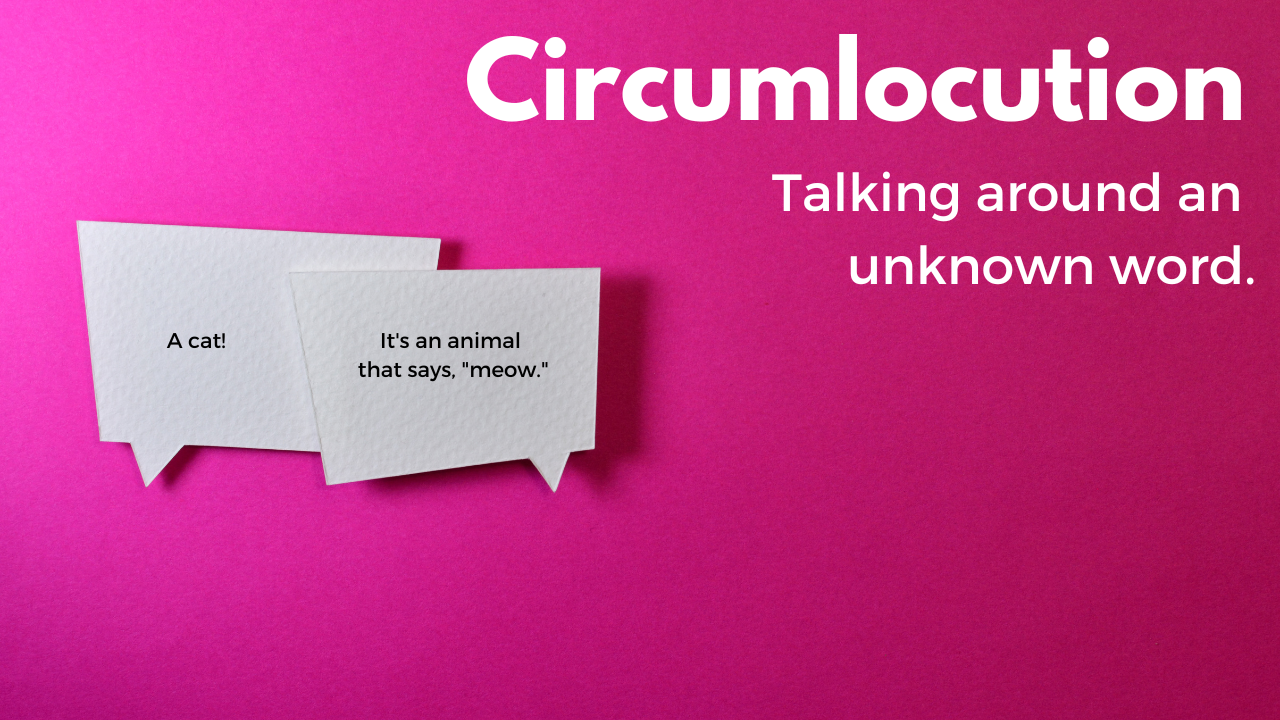
Let's face it. Our students will never remember every word that we teach them. And they're never going to know thousands and thousands of words.
So what are we to do as teachers?
The answer to that is the topic of this article: circumlocution.
We teach them how to circumlocute!
This is a natural process of talking “around” words we don’t know in our native language.
But it doesn’t always come naturally in a second or third language.
And that’s where we come in!
We can help students learn to circumlocute.
So read on and I’ll share with you my 3 steps to teaching students how to use this important skill.
- Circumlocution Posters
The first step is to make sure you have circumlocution posters hanging in a prominent spot in your classroom.
You can download my free set at imim.us/circumlocutionposters.
These posters depict important keywords for circumlocution: person, animal, thing, place, and idea.
This way, when a student doesn’t know a word, I’ll start by directing them to the posters so they start to talk “around” the word they don’t know.
I’ll ask them if it’s a person, animal, thing, place or idea.
Then I’ll ask leading questions to try to narrow down the search.
Even if I know the word they’re looking for, I’ll lead them down this path to teach them how to do this so they’re prepared when I’m not there to help them.
I always laugh at some of the funny combinations my students come up with!
I’ve had dogs that meow for cat, or bikes with no chair for scooter, and other funny things.
You have to marvel at their creativity.
- Describe
Description is the key to circumlocution.
We do this in our native language when we forget a word or don’t know what something is called.
I never let my student resort FIRST to a dictionary for an unknown word.
I tell them that you won’t always have access to a dictionary and they won’t always have data or wifi on their phone for Google Translate.
I explain that they need to describe the word until the other person gives them the word that they’re searching for or that there’s at least a mutual understanding of what you’re talking about.
I’ll often give an example or two in English so they recognize what I’m talking about.
Once they hear it done in their native language, they’ll have an idea of what it looks like and may even remember a time or two when they’ve actually done it.
So whenever they ask me for a word, I start by pointing to the posters and that gets the process rolling.
I may need to ask them some pointed questions to hone in on the word they’re looking for but every time we go through this process with every student who asks for a word, it’s an opportunity to teach them the process.
3. Dictionary
The last step in the process is using a dictionary.
After we’ve gone through the process of circumlocution, I’ll follow it up with a dictionary.
I’ll project on the screen an online dictionary and we’ll do the search together.
For French and Spanish, I use wordreference.com.
For German, I use dict.cc
When I look up a word, I explain the process that I go through to find the right translation for the word I’m looking for.
I show them that the first word that pops up isn’t always the correct translation for what they’re looking for.
For example, if they’re looking for the word “date” but the romantic one, the first word in the dictionary is usually the calendar date, so they actually have to read through the entries and the examples to determine which word is the correct word.
I’ll even read some of the extended examples that use different combinations of the main word that might actually change the word that we need.
The English word “run” is a great example.
We use this word for a lot of things; refrigerators run, noses run, rivers run, cars run, etc.
But, in most languages, they don’t use the word “run” the same way.
So to avoid funny sentences, we have to read all of the entries for “run” in the dictionary to find the right word for the right situation.
By teaching students how to talk "around" unknown words and how to use the dictionary, you are giving them useful skills that will translate outside of the classroom and give them the confidence to be able to navigate any conversational situation.
Download the FREE handy guide to my three-prong approach!



